Genre: Platformer Developer: Konami Publisher: Konami Players: 1 Released: 1994
Rocket Knight Adventures is a highly acclaimed game that is considered to be one of the pinnacle 2D platformers. It possesses great graphics, great sound, and great gameplay. C’mon–it even has a decent-ish storyline! Sparkster: Rocket Knight Adventures II is the sequel to that beloved game.
And it’s an entirely different story.
Let me just give you an overview of the game. You play as Sparkster, Rocket Knight, (that comes as no surprise, given the title) and you’re given the totally cliché task of eliminating a great evil (that would be Gedol), saving a kingdom (that would be Zebulos), and rescuing a princess (that would Princess Cherry, who, for variety, is not your sweetheart. Yay! But why are all princesses named after fruits?)
You bash through six platforming levels of action, slaughtering foes, collecting jewels, and searching for the seven Keys to the Seal, which will unlock your super power! Of course, you are not unarmed in your battle against Gedol! You have your trusty sword, which you can wield against your mighty foes! (Which consist of a bunch of lizards.) Seriously, though, I must admit that the sword is rather cool. You can swish-swish it around with great bravado. Then again… Ole Sparkster is a bit slow on the draw…instead of swish-swish it’s more like swish… swish… Despite that, the sword is a perfectly fine weapon.
And you have your rocket pack. At first thought you might not think that a rocket pack could do much damage to enemies, (second-degree burns, perhaps?) but once you see it in action you’ll quickly change your mind. Yes, the rocket pack is for travel, but more importantly it’s for HURLING YOURSELF BARBARICALLY INTO ENEMIES WITH SWORD OUTSTRETCHED TO SKEWER THEM! How brutal.
The rocket pack is actually a neat gameplay trick. You can use it to bounce around like a crazed pinball in narrow shafts, shoot along the sky, or simply commit the aforementioned evilness. Most reviewers of this game (and the first RKA) cite the rocket pack as the defining element that sets RKA apart from other platformers of the era, and mostly I agree with them. But I do want to say that I think the rocket pack was used much better in the first game than in the second. For instance: in the first there are Gradius-style shooter stages that use the rocket pack, but in Sparkster there’s nothing like that. But this is a review of Sparkster, not RKA.
Obviously you’ve got to have a kingdom to save, so let’s talk about that kingdom. Like I mentioned earlier, Sparkster has six levels, (seven if you count the interactive demo.) each of which has enemies, secrets, power-ups, bosses–everything you’d expect in a platformer. The first is a jungle/forest/grasslands level, (so common in first levels of mascot platformers) the second is a desert, the third is a ‘high speed air battle’, (Yeah. Right. Think the Wing Fortress zone from Sonic 2.) the fourth a forced-movement robot shooter, the fifth a techno/lab fortress, and the sixth a double boss fight.
An interesting note is that the levels’ length changes according to the difficulty level. On ‘Easy’ the game takes out some areas of the game, like the jungle in the first level, so you have to play on ‘Normal’ to get the full experience. (Incidentally, you can’t get all of the Keys to the Seals on easy, so you can’t really beat the game and see the ending unless you play on normal.) The levels are nicely designed and chock-full of variety. One minute you’re blasting through grasslands and the next you’re crawling through a jungle full of perils. The level design is probably one of the high points of the game.
Graphics are, of course, a part of the game which every review must cover. How are they in Sparkster? My answer: good. I compare them to Sonic 2, probably. My complaint is that the levels are all very… static. Don’t expect a ton of special effects like VectorMan. The levels have parallax and that sort of thing and little else. No fancy fog, rain, fire, lighting, or explosions. Just layered backgrounds and sprites. (But very nicely done backgrounds and sprites.)
The music is much better than the sound. The tunes are very good, and, while they don’t stick in your head, they are cool to listen to while you’re playing. The sound is decent, but most of the time it’s just crashes, beeps, and squawks. The enemies (except for a few bosses) are entirely silent, and Sparkster only opens his mouth when he dies or gets hit. (Silent and strong type, I suppose.) A little while ago I listened to all of the sounds in the sound test, and two things struck me. One: all of them sounded the same. Two: I couldn’t remember hearing many of them in the game. You draw your own conclusions.
What’s left to say? I guess a summary.
My review was probably overly negative– I just don’t generally gush in my reviews. Everything about the game is decent. Nothing outstanding, nothing awesome. Good for a weekend’s gaming, but for most people probably not much more. Average is probably the single term for Sparkster. Average graphics, average sound, average gameplay, average story, average characters. There are good things about it, but quite a few disappointments, too. What is probably most disappointing about Sparkster is that it is so different from the perfection of RKA. The sword works differently, the rocket pack works differently, Sparkster himself is different, the level types are different, etc. It feels like a totally different game. It isn’t a bad purchase by any means, but don’t feel like you’re missing out on a great experience with Sparkster.
SCORE: 5 out of 10

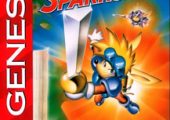
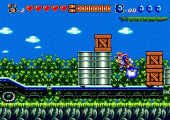
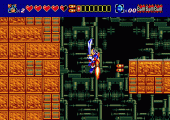
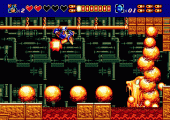
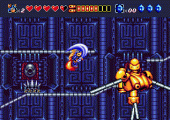
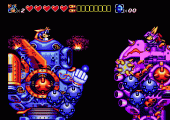
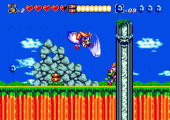
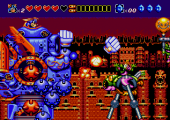
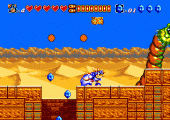
Recent Comments